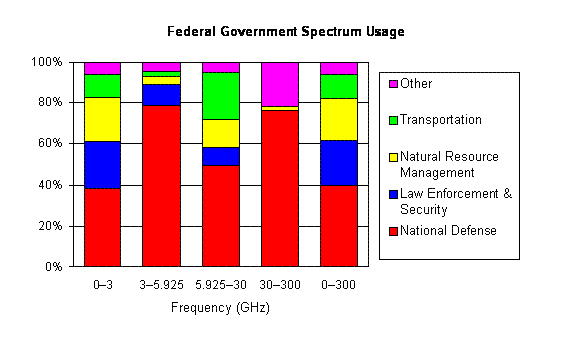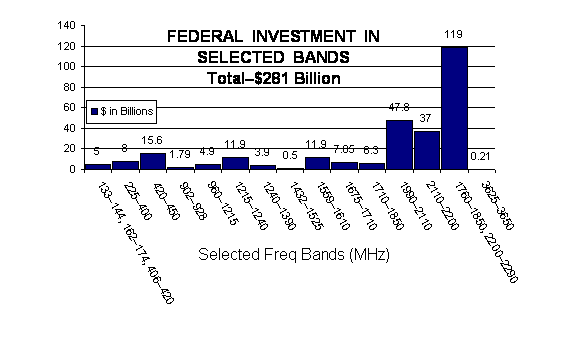The chart below shows some different ways that the federal government uses the spectrum to help in the accomplishment of its tasks. These uses include Voice of America broadcasts, weather radio services, radars and voice communication systems used to control both commercial and private aeronautical and maritime traffic, weather satellite systems, flood warning and water control systems, and time signals. Almost 93 percent of the assignments authorizing government radio stations are below 3.1 gigahertz (GHz). The Department of Defense (DOD) uses a significant portion of the federal government spectrum for national security purposes. The federal government uses only the portions of the spectrum that it needs to provide critical public services, and seeks to deploy the most efficient technology consistent with available resources.

Almost every agency of the federal government uses the spectrum in performing mandated missions. Two dominant themes are always present in the government's use of radio:
- The requirement for telecommunication is placed upon the federal agencies by virtue of the missions and programs approved by the President consistent with congressional legislative and funding support.
- The use of radio, rather than other forms of communications, is dictated by the type of service required and the inescapable elements of time and space.
The law enforcement agencies (e.g., Department of Homeland Security, Justice, Treasury, and Interior Departments) use the spectrum for command and control of their forces, just as state and local police and fire departments do, with the exception that they must be able to operate throughout the United States. The Federal Aviation Administration uses it for safety services such as aeronautical radionavigation, precision landing systems for all weather operations, surveillance, and air/ground communications. The Department of Agriculture Forest Service rangers use the spectrum every time they use their transportable radios for control of crowds or forest fires. The Department of Energy uses it to transmit power control data and commands for their dams and power grids. The Department of Homeland Security uses it for the protection of the United States and for communications in disaster areas via emergency radio networks. The National Aeronautics and Space Administration (NASA) uses it during satellite launches for communications with satellites to collect data and command them. NASA must also use the spectrum to track launch vehicles and satellites and destroy them if necessary. The DOD uses the spectrum extensively for tactical and nontactical uses. In the United States, tactical uses are generally limited to several specific testing sites and training areas and facilities. However, DOD's nontactical applications are extensive and include aircraft command and control, mobile communication at military bases and air fields, and long-distance communications using satellites.
The distribution of frequency assignments reflects the federal government's use of the spectrum. Its investment in selected bands below 3650 megahertz (MHz) totals about $281 billion, as shown. This investment in technology affects the federal government's ability to relocate to new spectrum bands. The federal government reallocation of 235 MHz to the private sector, for example, will cost taxpayers an estimated $500 million to move the federal government users. (Please note that the $100 billion investment in the 1760-1850 and 2200-2290 MHz bands includes most federal space systems, but not the federal investments of $5.3 billion for fixed and mobile service operations in the 1710-1850 MHz band.)

In understanding the federal government's use of the spectrum, one must appreciate the interplay between federal government and non-federal government use of the same spectrum. In addition to the shared use of the same sections of spectrum for unrelated purposes, there is a substantial interface between government and non-government radio operations. Government radio facilities provide-private sector ships and aircraft communications, navigation, and surveillance service; federal law enforcement agencies have intercommunication with their state and local government counterparts; federal electrical power systems interconnect with non-federal power systems, both domestic and international; Civil Air Patrol stations communicate with the military-and so forth.
There can be little argument that some form of coordination of operating frequencies and transmitting powers is necessary; after all, the present structure was developed largely because of the interference problems resulting from uncoordinated broadcasting and long-distance (high frequency) transmissions common during the first two decades of the 20th century. While most radio spectrum is very congested, it is not normally necessary to regulate tightly spectrum in those portions of the spectrum that are not congested. Thus, as long as the spectrum is plentiful, merely assuring that two users do not operate in the same part of the spectrum in the same area is sufficient. As the spectrum becomes more crowded, efforts to ensure that the spectrum is used as efficiently as possible to maximize its availability to and use by all become more urgent.

